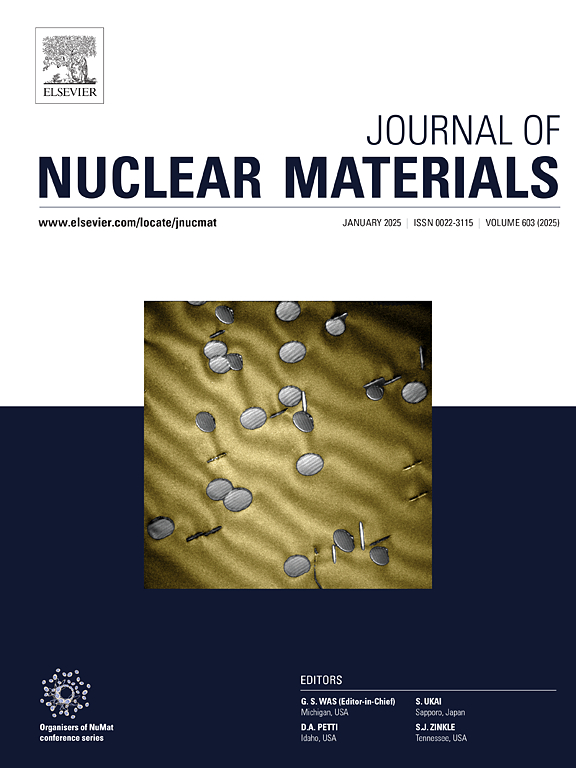Flow-Accelerated Corrosion and Wall Thinning Mechanism of a Dissimilar Metal Welded Joint in the Secondary Loop Piping System of Pressurized Heavy Water Reactors
IF 2.8
2区 工程技术
Q3 MATERIALS SCIENCE, MULTIDISCIPLINARY
引用次数: 0
Abstract
This study investigates the flow-accelerated corrosion (FAC) failure in a dissimilar metal weld joint (DMWJ) of a decommissioned secondary loop piping elbow from a nuclear plant after 20 years of operation in China. Comprehensive macroscopic and microscopic failure characterizations were conducted to elucidate the wall thinning mechanism. High-temperature electrochemical galvanic corrosion tests and computational fluid dynamics (CFD) simulations were performed to validate the proposed thinning mechanism. The results reveal that the SA106B carbon steel (CS) piping near the weld joint exhibits a typical scallop-shaped two-phase FAC morphology. Notably, the maximum wall thinning, reaching 1.404 mm, was observed in the SA106B heat-affected zone (HAZ) adjacent to the fusion boundary. The galvanic corrosion tests and CFD calculations confirm that the wall thinning is governed by a combination of galvanic corrosion, driven by the potential difference between CS and stainless steel (SS), and significant localized flow turbulence induced by weld reinforcement. The localized flow turbulence increases wall shear stress (WSS), liquid film thickness, and liquid droplet impingement (LDI), contributing to both erosive and corrosive effects, ultimately enhancing wall thinning. Special attention should be given to evaluating the thinning at the weld fusion line during non-destructive failure examinations of piping systems.
重水堆二次回路管道系统异种金属焊接接头流动加速腐蚀及壁薄机理
本文研究了中国某核电站运行20年的退役二次环管弯头异种金属焊接接头(DMWJ)的流动加速腐蚀(FAC)失效。通过宏观和微观的综合破坏表征来阐明壁厚变薄的机理。通过高温电化学电偶腐蚀试验和计算流体动力学(CFD)模拟验证了所提出的减薄机理。结果表明:焊接接头附近的SA106B碳钢(CS)管材呈现典型的扇形两相FAC形貌;值得注意的是,在靠近熔合边界的SA106B热影响区(HAZ)观察到最大的壁薄,达到1.404 mm。电偶腐蚀试验和CFD计算证实,壁面变薄是由CS和不锈钢(SS)之间的电位差驱动的电偶腐蚀和焊缝加固引起的明显的局部流动湍流共同控制的。局部流动湍流增加了壁面剪切应力(WSS)、液膜厚度和液滴撞击(LDI),同时产生侵蚀和腐蚀效应,最终增强了壁面减薄。在管道系统的非破坏性失效检查中,应特别注意评估焊缝熔合线上的变薄。
本文章由计算机程序翻译,如有差异,请以英文原文为准。
求助全文
约1分钟内获得全文
求助全文
来源期刊

Journal of Nuclear Materials
工程技术-材料科学:综合
CiteScore
5.70
自引率
25.80%
发文量
601
审稿时长
63 days
期刊介绍:
The Journal of Nuclear Materials publishes high quality papers in materials research for nuclear applications, primarily fission reactors, fusion reactors, and similar environments including radiation areas of charged particle accelerators. Both original research and critical review papers covering experimental, theoretical, and computational aspects of either fundamental or applied nature are welcome.
The breadth of the field is such that a wide range of processes and properties in the field of materials science and engineering is of interest to the readership, spanning atom-scale processes, microstructures, thermodynamics, mechanical properties, physical properties, and corrosion, for example.
Topics covered by JNM
Fission reactor materials, including fuels, cladding, core structures, pressure vessels, coolant interactions with materials, moderator and control components, fission product behavior.
Materials aspects of the entire fuel cycle.
Materials aspects of the actinides and their compounds.
Performance of nuclear waste materials; materials aspects of the immobilization of wastes.
Fusion reactor materials, including first walls, blankets, insulators and magnets.
Neutron and charged particle radiation effects in materials, including defects, transmutations, microstructures, phase changes and macroscopic properties.
Interaction of plasmas, ion beams, electron beams and electromagnetic radiation with materials relevant to nuclear systems.
 求助内容:
求助内容: 应助结果提醒方式:
应助结果提醒方式:


